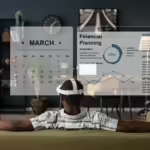Fintech Apps: UX guidelines on how to build winning fintech products

What is a Fintech App?
Fintech, the beautiful amalgamation of finance terrain and leading-edge technology, is today pioneering digital disruption solutions across industries. Fintech apps are not only democratizing the markets, allowing new players in the arena but also accelerating digital transformation in every sphere possible.
Fintech bordering industries such as AI, ed-tech, digital health, etc are undergoing massive transformations, leaving behind legacy culture and adopting more efficient systems. There is exponential growth in the fintech industry that now has a direct impact on institutions, policies, and development strategies.
This means one important thing for designers. If you are working on a fintech app design, you have to understand its implications first in order to design a system that is
- Safe and secure
- Trusted by users
- Keeps them engaged & informed
- Helps build better financial habits
- Evokes positive emotions
Without much ado, let’s get down to understanding fintech from the POV of design.
Before designing a fintech app, understand fintech: What is fintech?
Finance is no longer what it used to be a decade ago.
In fact, it’s not even close to what it used to be some 5-6 years ago.
The past decade has marked exponential changes in how we handle money and financial transactions. A field that was once dominated only by credit and debit cards has now opened an arena for digital wallets, e-payments, and mobile wallets. Things that have made handling physical currency obsolete.
Fintech entities aim to revolutionize the entire gamut of financial behaviors we practice today. They can range from enabling novices to easily invest in stock markets to teenagers to start building money-saving habits.

Almost all banks now have a mobile app version, a mini digital version of traditional & large legacy systems in the pockets of millions of their customers.
Another segment of fintech app designs gaining fast popularity is the microloan app. Fintech apps that, within proper regulations and guidelines, provide small-scale loans to individuals and small businesses, fast-tracking gig-economy culture.
From paying credit card bills to finding the best mutual fund investment – for every kind of financial transaction, there is an app. A simple tap of a button and a world of easy & secure payments open for you where there are no long lines or tons of paperwork involved.
Fintech apps v. Legacy systems: Why there is a clear winner
Why is it that people are slowly moving away from conventionally stable banks and other financial institution formats to the lightning fast fintech boom?
- Freedom is a big priority when it comes to millennials (the key influencing demographic in today’s world). They don’t care much about committing to a particular bank or financial institution. What they do care about is having ease and convenience.
- For this very demographic, it is also important to have peer-to-peer collaborative networks. It’s not enough to just sign up for a product or service. They need to feel that they are a part of a bigger community and/or movement.
- Long-standing queues at banks, bustling through a ton of paperwork, and facing bureaucratic obstacles at every point. Be it opening a new account or applying for a loan for your business. Fintechs have streamlined and simplified processes that were once heavily bound by red tapes.
- The overall formal, dull, information-heavy, and impersonal tone of traditional legacy systems and banks is no longer welcome.
- Fintechs are actually decentralizing the banking model, removing middlemen, and putting the power back into the hands of the public.
This means in order to design an effective fintech app that is loved by users it must focus on all the factors that make it inherently the better choice:
- Simplification of complex processes
- Easy-to-understand language
- Flexibility
- Warm & personal tone
- Freedom from brick-and-mortar entities
- Digital-first presence
- Stuff that makes finance interesting, engaging, and delightful rather than a chore
Must-know fintech apps design guidelines
Now that we have a set of fintech design heuristics to refer to, let us get started on the specifics of how to make a fintech app design shine.
Focus on the journey of a fintech app user
Regardless of the industry, one rule that stands true in the case of design is that – customer experience drives user acquisition. And in order to establish the right model for your fintech app, you need to ensure that the user is motivated to use the app.
How do you do that?
The app should
- Resolve a persisting user hardship
- Bring something new to the table
- Add value to the user’s life
- Enhance convenience
This is precisely why it is pertinent to grasp the 5W+1H (what, why, when, where, which, how) of the fintech product. Equally important to understand your target demographic (small business owners or amateur stock traders) and the stakeholders.
Placing appropriate CTAs at the right places can help ease your user’s way into the product. And not to forget, the desired actions must be supplement with the right information.

Simplify the fintech design to reduce cognitive load
It’s common knowledge that finance is a largely convoluted sphere. And not to mention, an average user is unlikely to be an expert in money matters. Thus, it’s important that fintech app designs have a rugged user-centric approach.
This means creating fintech app designs that
- Translate complicated financial data into easy to understand insights
- Don’t overwhelm users with a deluge of information
- Guide users to perform the desired action in a step-by-step manner
- Not just perform heavy calculations but also convey the meaning and significance of the numbers
One of the key ways to achieve this is impeccable data visualization. Here, it means parsing complex financial data and presenting it to the user in easy-to-digest formats. This mainly includes pie charts, graphs, and so on.
Not only does this practice help in retaining users and boosting engagement, but it also increases the visual appeal and aesthetics of the fintech app design.
With the right application of data visualization in fintech app design, you can also enhance financial literacy among your users, making them more prudent and informed with their savings and expenditures.

Leverage friction to make fintech designs safer & secure
“Seamless” and “hassle-free” features are great to have unless friction is your best friend. And sometimes, having a “poor” UX design in your fintech app is paradoxically a good thing.
But why?
In the world of money, friction can sometimes help avert financial disasters.
Though users are looking for easier, more convenient ways of handling their money, you don’t want to design systems where it’s equally easy to make financial blunders.
Imagine sending a huge sum of money to the wrong person. Or, not having a multifold security check before logging into your account. Or think of a situation where the amount gets debited from the account with prior information or notification to the user.
In all these cases, though the features are designed to make things easier for the user, missing the required friction here can mean heavy and irreversible losses for the users.
You don’t want to design a fintech app where people lose their money easily. This means you should infuse a healthy level of friction in your fintech product to add layers of safety in the transactions.

Fintech app design for higher trust and transparency
Firstly, how do you know if a fintech app design is not transparent enough? Or that users don’t trust it?
Though it is difficult to generate metrics that measure trust and transparency (extremely subjective matters), you can still find the answer. The following patterns will help you
Users not sure if an action has been performed
They are unsure that said action is effective
They keep repeating the same action
Users are unaware of which step in the entire process are they on
They feel stuck when using your product
High-dropout rates
Users are confused on how to proceed, right from the beginning
It can be highly frustrating for users to NOT know what is happening and where the money is going. To avoid such debacles, try to follow these fintech design app best practices for higher trust
Provide users clear information about the consequences of their actions
Apart from in-app notifications utilize other channels to keep users informed
Explain what happens next with each step
Show what’s in progress (verification, waiting for otp, uploading docs, etc.)
Weave security in your app via hardened encryption, biometric security, & more
Keep the language jargon-free. Communication only works when it’s understood. And only clear communication with your users will help you build trust.
fintech mobile app design
Create a warm, positive, and personalized experience for your users
As mentioned earlier, users have had enough of the curt, dull, and drab tone of legacy financial institutions. What they are actively seeking is a reliable digital ally that will help them perform tasks with ease without overwhelming them. Your fintech app design should ideally make going to a bank/brick and mortar entity 100% obsolete.
And instead, create a comprehensive digital-first ecosystem that is driven by positive emotions and talks to them in their language.
Here are some quick tips to ensure a warm and personalized experience for your users.
Add engaging and fun elements to your fintech app design. Starting from aesthetically pleasing colors (that are relevant to your fintech branding) to illustrations, iconography, animations, micro-interactions – there are a host of visual design elements you can use.
The microcopy has to be engaging, personal, and conversational. It should make the user feel that the fintech app is created just for them. Instead of plainly stating out information, try to engage in conversations with your users through your fintech app design.
Keep the flow clean, subtle, and smooth. Minimal and simple designs will work in your favor instead of having text/feature-rich interfaces.
Statistics reveal that roughly 60% of users form a less than split-second opinion on whether they like your product or not based solely on the visuals. It is thus important to have the visual design language of your fintech app well-aligned with the business goals and the target audience.
Having a personalized chatbot or virtual concierge that guides your users throughout the app is a great way to establish a personal connection with your user. This user-friendly and intuitive feature will add a human element to the process making your fintech app more sticky.
fintech mobile app design
Fintech app design for positive habit formation
Gone are the days when users were satisfied with the usual credit/debit SMS notifications on the phone. Today users want fintechs to do more than just show them a glimpse of their savings, expenditures, etc.
They want a highly trusted finance partner who can nudge them to make the right financial decisions, someone who will help them move from a finance novice to a financially matured user.
If your fintech app design can unlock the code of positive behavior formation, then you have hit the jackpot. Here are a few great examples of how fintech app design can encourage positive habit building.
Apps that reward users that save/invest their money wisely, hit their savings/investment targets, and so on.
Fintech app feature which increases friction when the user is spending more than the pre-set monthly amount. This can be customized to certain categories such as ordering food online, traveling by cabs, having expensive coffee, etc. – stuff which the user can set as being frivolous expenditures.
Fintech app designs that help users file their tax returns and help them find better investment options.
To sum it all up
To design a winning fintech product you need to
- Have an in-depth understanding of how the world of finance works and where the legacy incumbents are lacking in serving your users.
- Freedom, personal connection, sense of belonging, and convenience are the biggest driving factors when it comes to designing a fintech app
- The entire fintech app design language must be aligned with your user’s core pain points. The visual design, the microcopy, CTAs – everything must be designed keeping in mind your user’s journey.
- Trust and transparency are the #1 priority. Users should be able to trust your platform with their hard-earned money.
- A fintech app should be warm, personalized, cordial, and intuitive.
- Leverage positive friction to shield your users from making financial mistakes on your platform.
- Analyze how you can utilize your platform to empower your users through positive habit formation.


